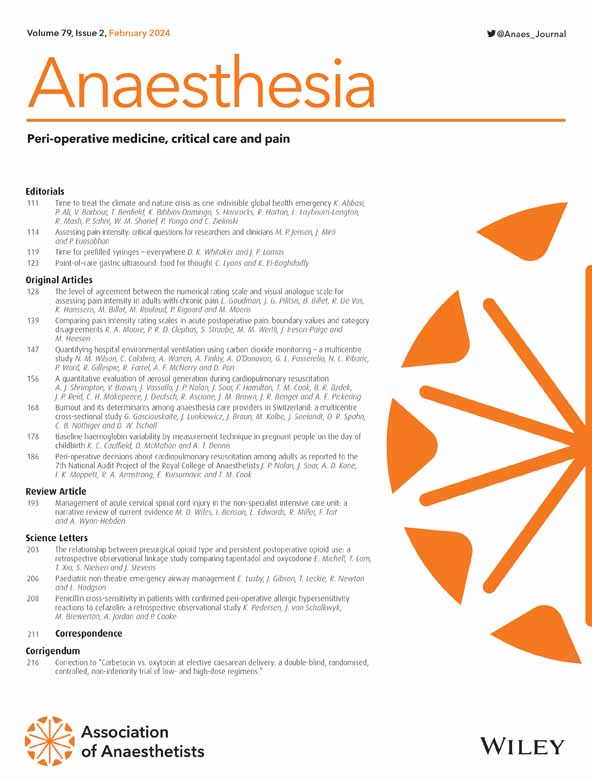院前中心静脉通路治疗因严重创伤引起的失血性休克的观察性研究
IF 6.9
1区 医学
Q1 ANESTHESIOLOGY
引用次数: 0
摘要
主要外伤引起的失血失血性休克具有高死亡率。快速静脉补血是早期治疗的关键要素。当不能获得外周静脉通路时,院前放置大口径中心静脉导管(称为创伤导管)可以是一种挽救生命的选择。方法采用回顾性队列研究,评价院前应用14-Fr创伤线治疗因严重创伤导致的出血患者的可行性、有效性和安全性。通过交叉参考院前患者护理记录、急诊科记录、手术记录和尸检结果,确定创伤线插入的成功率、结果和并发症。结果在2019年1月1日至2023年7月31日期间,伦敦空中救护车接待了8104名患者。346例(4%)患者尝试插入创伤线,276例(80%)患者成功。与插入失败的患者相比,成功插入创伤线与院前血制品输血显著增加相关(中位数(IQR[范围])分别为4(2-6[0-12])和2(0-4[0-8])单位;p < 0.001)。成功插入创伤线后到急诊科的生存率更高(149/279 (54%)vs 25/70 (36%);p = 0.006)。184例(53%)患者被送往医院。本组8例(4%)患者出现并发症:创伤线错位(n = 3);血管损伤(n = 2);医源性气胸(n = 2);创伤线尖端培养阳性(n = 1)。对于严重休克或外伤性心脏骤停的出血性出血患者,院前创伤线插入是可行的,并且与可接受的手术并发症风险相关。创伤线能够在院前环境中输送更大容量的血液制品,这可能与院前生存率的提高有关。本文章由计算机程序翻译,如有差异,请以英文原文为准。
An observational study of pre-hospital central venous access for patients with haemorrhagic shock due to major trauma.
INTRODUCTION
Exsanguinating haemorrhagic shock due to major trauma is associated with high mortality. Rapid intravenous volume replacement with blood products is a crucial element of early treatment. When peripheral intravenous access cannot be obtained, pre-hospital placement of a large-calibre central venous catheter, known as a trauma line, can be a life-saving alternative.
METHODS
This was a retrospective cohort study to evaluate the feasibility, efficacy and safety profile of inserting a 14-Fr trauma line in patients with exsanguinating haemorrhage due to major trauma in the pre-hospital setting. Success rates, outcomes and complications of trauma line insertion were determined by cross-referencing pre-hospital patient care records with emergency department notes, operating notes and post-mortem findings.
RESULTS
Between 1 January 2019 and 31 July 2023, London's Air Ambulance attended 8104 patients. Trauma line insertion was attempted in 346 (4%) patients with success in 276 (80%). Successful trauma line insertion was associated with significantly greater transfusion of pre-hospital blood products compared with those in whom insertion was unsuccessful (median (IQR [range]) 4 (2-6 [0-12]) vs. 2 (0-4 [0-8]) units, respectively; p < 0.001). Survival to presentation to the emergency department was higher after successful trauma line insertion (149/279 (54%) vs. 25/70 (36%); p = 0.006). There were 184 (53%) patients transported to hospital. Complications in this group were reported in 8 (4%) patients: malpositioned trauma line (n = 3); vascular injuries (n = 2); iatrogenic pneumothorax (n = 2); and positive trauma line tip culture (n = 1).
DISCUSSION
In patients with exsanguinating haemorrhage who are in severe shock or traumatic cardiac arrest, pre-hospital trauma line insertion is feasible and associated with an acceptable risk of procedural complications. Trauma lines enable the delivery of a greater volume of blood products in the pre-hospital setting, which may be associated with increased pre-hospital survival.
求助全文
通过发布文献求助,成功后即可免费获取论文全文。
去求助
来源期刊

Anaesthesia
医学-麻醉学
CiteScore
21.20
自引率
9.30%
发文量
300
审稿时长
6 months
期刊介绍:
The official journal of the Association of Anaesthetists is Anaesthesia. It is a comprehensive international publication that covers a wide range of topics. The journal focuses on general and regional anaesthesia, as well as intensive care and pain therapy. It includes original articles that have undergone peer review, covering all aspects of these fields, including research on equipment.
 求助内容:
求助内容: 应助结果提醒方式:
应助结果提醒方式:


